Table of Contents
Pretty much everyone encounters knee pain at some point in their life. It’s really not pleasant when you suddenly can’t fully enjoy sports and even casual daily movements become problematic. Nonetheless, there are still plenty of ways to stay physically active. The key lies in choosing specific types of exercises that don’t strain the knees as much. If you approach this issue correctly, these activities can even assist in regaining normal mobility and joint function.
Why exercise with painful knees?
You might have immediately thought that when your knees hurt, it’s better to let them rest. This holds true for acute pain caused by injury, but when it comes to chronic (long-term) knee pain, reduced activity can lead to stiffness and decreased mobility. On the contrary, suitable exercises recommended by a physiotherapist can help strengthen the muscles, tendons, ligaments, and other supportive structures around the knee. Moreover, during movement, they get lubricated by synovial fluid, which reduces friction between joint surfaces. This is crucial for maintaining the health of cartilage. In the end, appropriate movement can help you gradually regain strength and knee mobility. [1]
In addition, it’s important for your overall physical and mental well-being to engage in regular physical activity, at least 150 minutes per week. However, this doesn’t mean that you have to be lifting weights at the gym for 2 hours straight. Even a walk, a short bike ride, or some stretching counts. That’s why it’s crucial for everyone to find an activity that suits them. [5]
- If you’re curious about the most common causes of knee pain and popping, you’ll find more information in the article: Knee Popping and Pain: Common Causes and Suitable Exercises
- We delved even deeper into the issue of joint popping in the article: Joint Cracking and Popping: A Common Phenomenon or a Warning of a Problem?
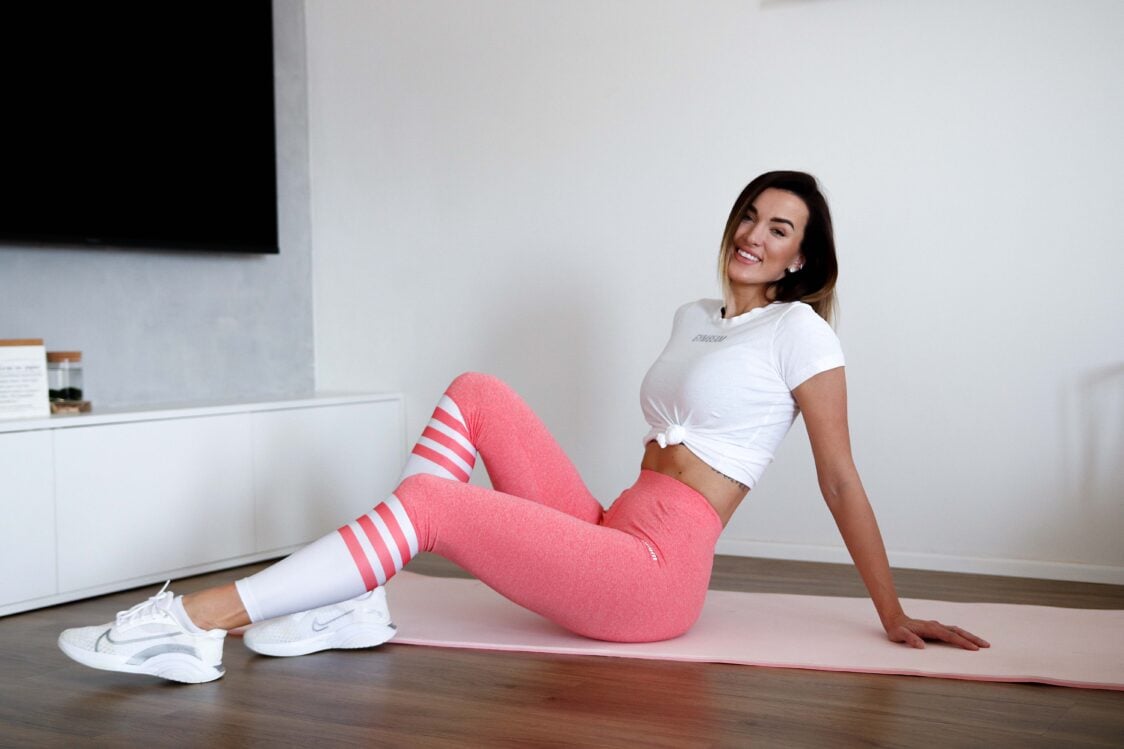
7 Types of Suitable Sporting Activities
If you experience long-term knee issues, always consult a doctor or physiotherapist before engaging in any sports. They can provide the best advice based on a movement diagnosis and a comprehensive assessment of your problem. They’ll guide you on what’s suitable for you and what to avoid. Everyone’s preferences and needs vary, and it always depends on your individual situation. If you try any of the below types of movement activities and experience a significant increase in discomfort, consider reducing the intensity, range of motion, or repetitions. If worsened pain persists, it’s better to stop and try something else.
Start a new sporting activity slowly. Always warm up and stretch lightly before engaging in it. Gradually increase the duration, intensity, or number of repetitions based on how your knees respond. This might introduce a new type of stress to your body that it needs to adapt to. [9]
In addition to proper exercise, you can also support your knees with joint supplements. To help you select a high-quality supplement, be sure to check out the article: How to Choose the Best Joint Supplement?
You might be interested in these products:
1. Swimming
Swimming is an ideal cardio activity that you can usually do even with knee problems. Because the water supports you, there’s less strain on the joints compared to activities like running. Additionally, you’ll work on joint range of motion and flexibility in doing so. With each stroke, you also overcome water resistance, leading to overall body strengthening. Swimming has the added benefit of stretching chest muscles which can be often shortened and working the weakened muscles between the shoulder blades. This can contribute to better posture. [2]
In addition to regular swimming, you can also try various water-based classes like aqua aerobics or strength training.
If you’re still unsure whether to give swimming a chance, the article “8 Benefits of Swimming That Will Get You Into the Pool Today” might convince you.
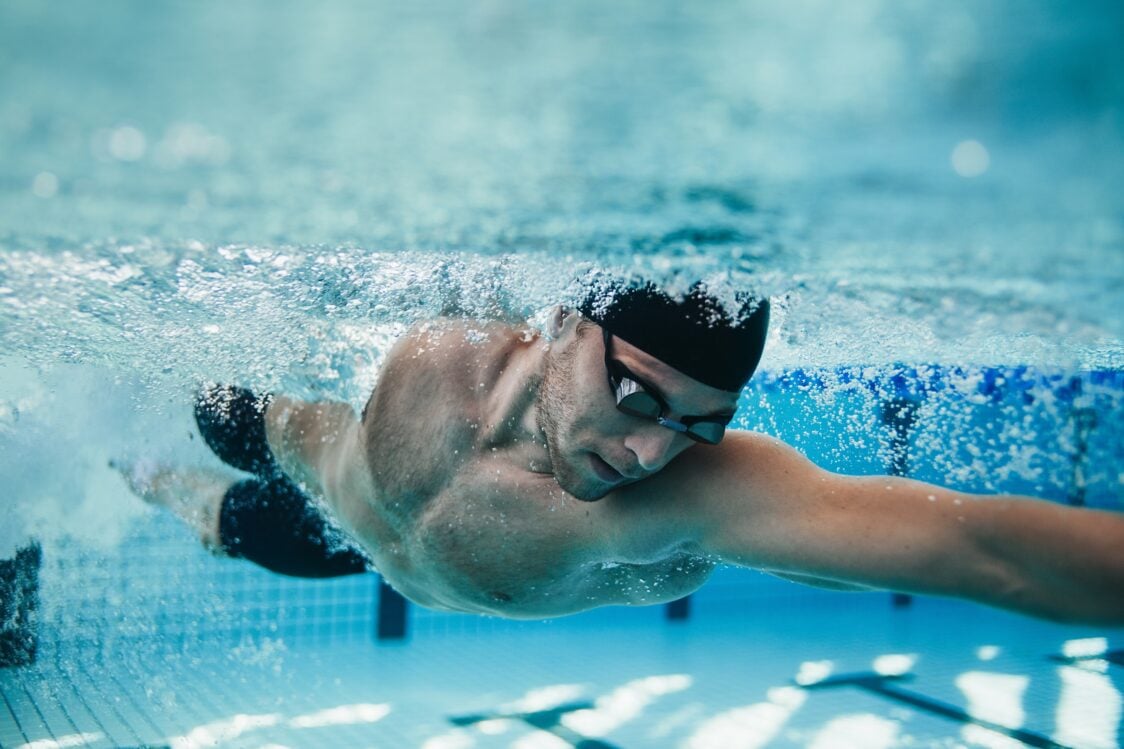
2. Walking With or Without Trekking Poles
Regular walking is the most natural activity for our body. It doesn’t strain the musculoskeletal system as much, yet it effectively moves the joints to lubricate them with synovial fluid. Apart from joint lubrication, this fluid also nourishes the cartilage, which lacks its own blood supply. Therefore, nutrients primarily reach it while you move around. That’s why it’s important to stay active, even if our knees don’t function as well as they used to. [3]
However, when you embark on longer hiking trips, it’s always a good idea to bring trekking or Nordic walking poles along. With these, you engage the upper body muscles while walking. This reduces the load on the knees and hips, and likely increases your speed as well. Walking with poles, especially Nordic walking, is often recommended by orthopaedists for individuals with osteoporosis, arthritis, or other musculoskeletal conditions, particularly joint-related issues.
If you’re curious about what benefits hiking can bring you, read the article: Mental Well-Being, Weight Loss and Improved Sleep. What Are Other Benefits of the Great Outdoors?

3. Cycling or Using a Stationary Bike
Cycling, whether it is outdoors or on a stationary bike, is another endurance activity that is commonly recommended for people with problematic knees. Similar to swimming and walking, cycling doesn’t impose as high a strain on the joints. Riding a bike also facilitates joint lubrication and strengthens the muscles and ligaments around the knees. This can contribute to enhancing the overall joint functionality. [4]
When cycling, it’s best to choose well-paved roads and bike paths. On the other hand, avoid trails and forest paths, as large potholes or uneven surfaces could potentially worsen the condition of your knees.
You can find all recommended things to bring on a cycling trip and tips how to ride safely in the article: How Can You Enjoy Cycling Safely? 7 Tips for Novice and Advanced Cyclists

4. Yoga or Pilates
Yoga isn’t just simple stretching. It’s an activity that focuses on joint range of motion, enhances flexibility and body posture, while simultaneously relaxing and strengthening muscles. Pilates offers similar effects as well.
While experiencing knee pain, you might not be able to perform all yoga poses, especially those that involve extreme knee bending. However, yoga can still be beneficial for you. You can start with gentler, meditative types of yoga like Hatha, Iyengar, or Kundalini. Ideally, attend a class guided by an experienced instructor.[6]
If you want to learn more about yoga and its health benefits, read the article: Yoga: The Key to Physical and Mental Balance

5. Massage Exercises
Massaging the leg muscles can help release stiff muscles that could also be contributing to knee pain. You can do this yourself using a foam roller or a massage ball. These tools are ideal for relaxing the glutes, thighs, and calves.
- Place the roller or ball beneath the muscle you want to massage, then gently press onto it using your own body weight and move your body in various directions. You can control the intensity of the massage by adjusting how much pressure you apply to the muscle against the tool.
- Similarly, you can use a massage stick or a massage gun. However, when using the massage gun, focus only on muscles, which are the soft tissues, and avoid bones and joints.
Massage tools are also ideal for supporting recovery. You can learn how to use them in the article: How to Support Regeneration Using a Massage Gun and Other Tools?
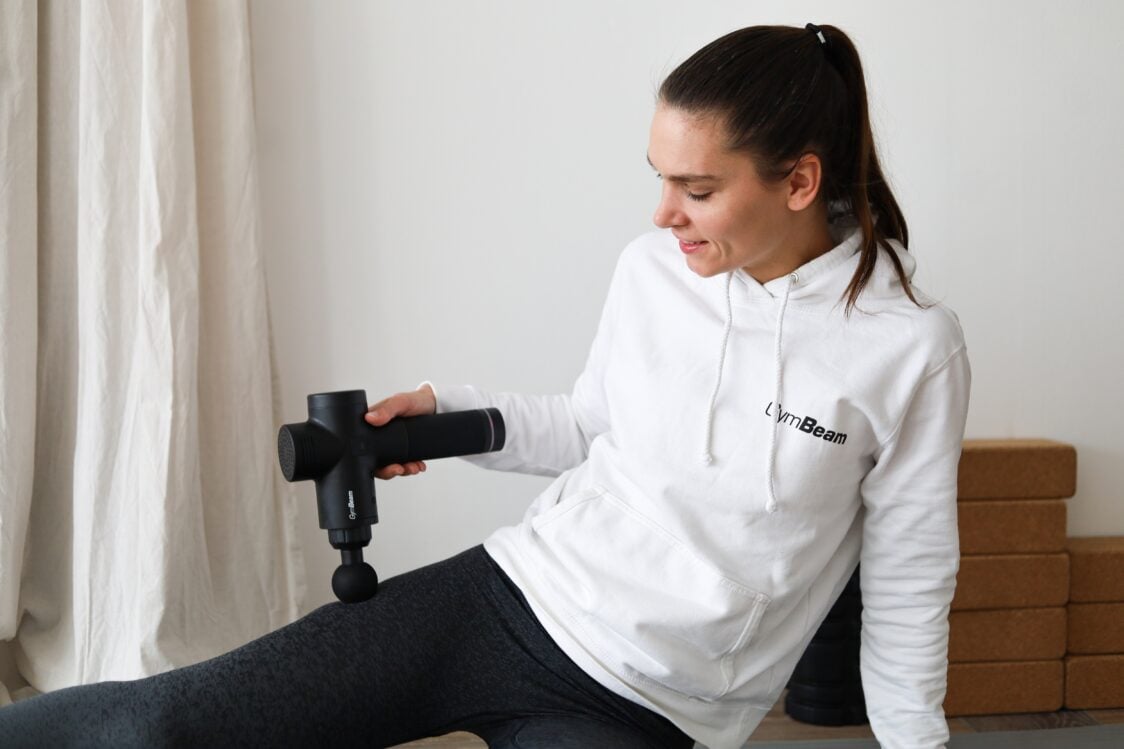
Discover our bestsellers:
6. Stretching and Relaxation Exercises
Stretching exercises can help increase muscle flexibility, ensuring they don’t limit the function of your knees. The issue of knee pain might stem from shortened muscles in the front (quadriceps) or back (hamstrings) of your thighs. You can incorporate some of the exercises below into your training routine, as they are generally recommended even during rehabilitation programs. However, it’s advisable to consult with an orthopaedist or physiotherapist regarding their suitability for you.
- For all exercises, it’s important to hold the stretch position for 20 to 60 seconds and repeat it at least 3 times.
1. Quadriceps Stretch
- Starting position: Stand upright, then bend the knee of one leg and use your hand to pull the foot up towards the glutes (or as far as your knee allows). Throughout the exercise, try to keep your knees close together. The leg you stand on can be slightly bent.
- Execution: Breathe in a controlled manner and try to hold this position for at least 20 seconds. Then switch legs. If you have difficulty maintaining balance, you can hold onto a chair or a bar for support.
- Common mistakes: Knees too far apart, leaning forward.
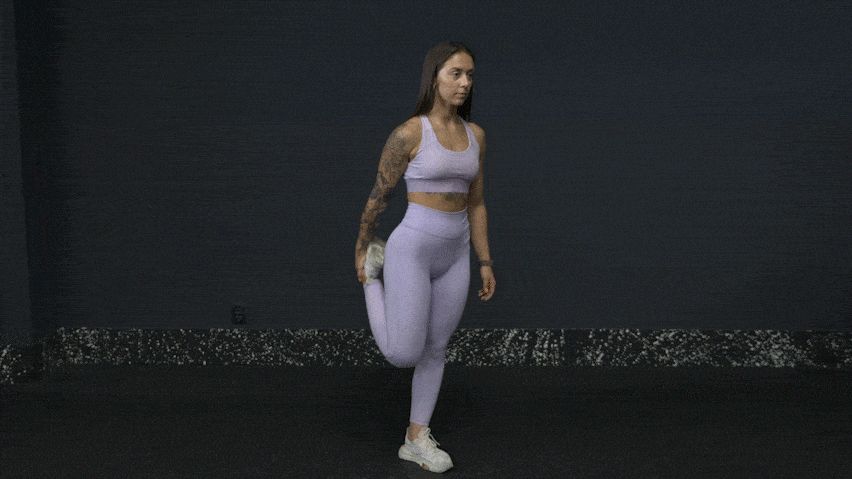
2. Hamstring Stretch
- Starting position: Stand upright with your feet together. Then take a small step forward with one foot, lean forward while keeping your back straight, lift the toes of the front foot, and try to reach it with your hands. The front leg is extended, and the back leg is slightly bent.
- Execution: Breathe in a controlled manner and try to hold this position for at least 20 seconds. Then switch legs.
- Common mistakes: Insufficient range of motion.
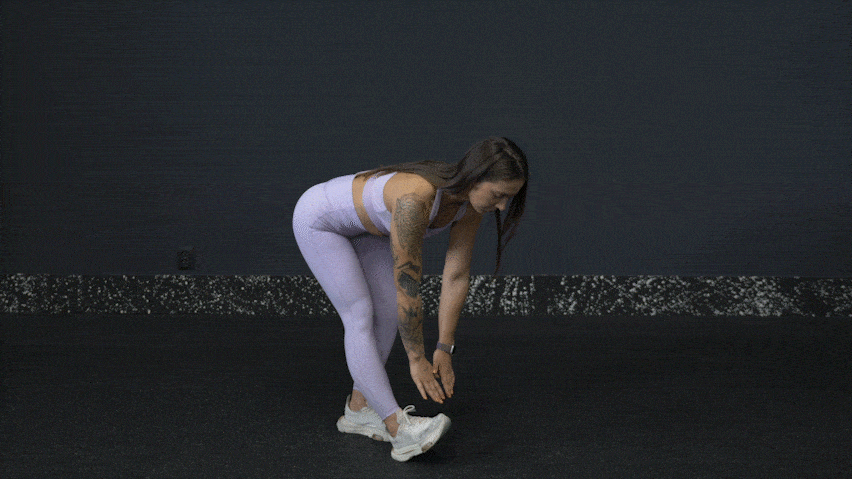
3. Lying Hamstring Stretch
- Starting position: Lie with your back on a mat, lift your leg, bend it slightly and use your hands to pull it a few centimetres closer to your chest.
- Execution: With each exhale, try to pull the leg closer. Continue this way for at least 20 seconds. Then switch legs.
- Common mistakes: Insufficient range of motion, lifting the lower part of the back off the mat.

4. Calf Stretch
- Starting position: Stand facing a wall or a power rack with a bar (approximately at shoulder level). Take a step forward with one foot and slightly bend it at the knee while keeping the back leg extended. Then, lean forward slightly, extend your arms, and either place your palms against the wall or grip the bar. Your feet should be flat on the ground.
- Execution: Breathe in a controlled manner and focus on stretching the calf of the back leg. Maintain this position for at least 20 seconds, then switch legs.
- Common mistakes: Insufficient range of motion.
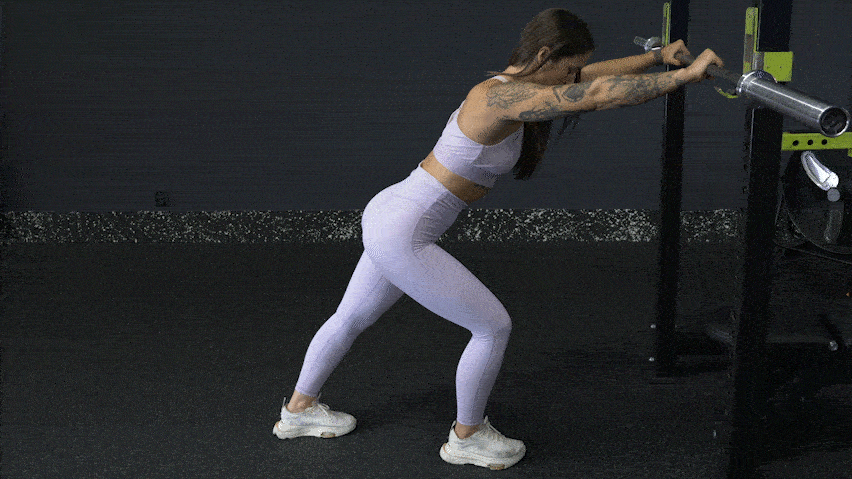
7. Rehabilitation Exercises
These exercises are ideal for strengthening the muscles of the lower limbs and the knee ligaments (anterior or posterior cruciate ligaments). These ligaments are crucial for the flexibility and stability of the entire knee, so it’s important to keep them strong and flexible.
1. Seated Leg Lifts
- Starting position: Sit on a mat with your legs extended and your back straight. Place your hands behind your body to support yourself.
- Execution: Upon exhaling, lift one extended leg a few centimetres off the mat in a controlled and slow manner. Hold this position for 1–2 seconds, then lower the leg back to the ground and continue with the next repetition. Switch legs after completing the series.
- Common mistakes: Uncontrolled movement.

2. Straightening Leg With Roller
- Starting position: Sit on a mat with a straight back and place your hands behind your body to support yourself. Bend one leg and position a foam roller with a smooth surface under the knee of the other leg.
- Execution: Upon exhaling, slowly straighten the leg that is resting on the foam roller in a controlled manner. Hold this position for 1–2 seconds. Then return it to the starting position and continue with the next repetition. Switch legs after completing the series.
- Common mistakes: Uncontrolled movement.
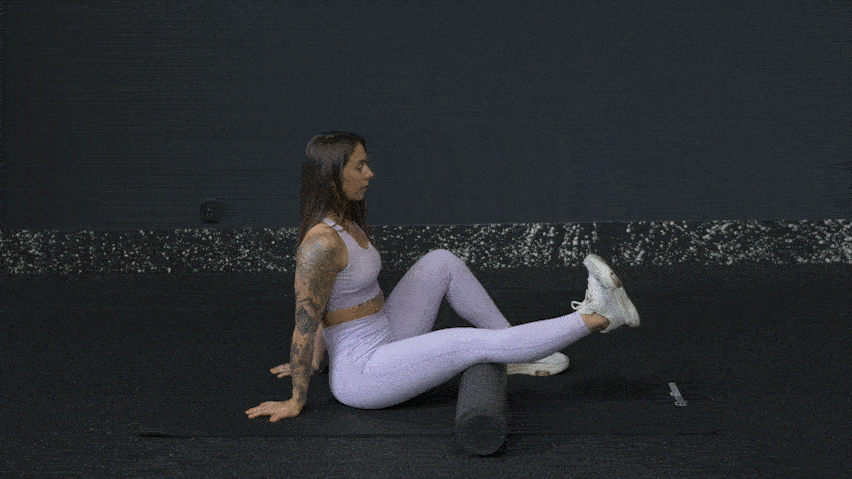
3. Glute Bridge
- Starting position: Lie on your back with your arms resting alongside your body, palms on the ground. Bend your knees, bringing them towards your hips, and keep your feet on the ground.
- Execution: By activating the gluteal and posterior thigh muscles, lift your pelvis upward. In the top position, focus on contracting the gluteal muscles. Hold this position for a second or two, then lower the pelvis down in a controlled manner. Continue with the next repetition.
- Common mistakes: Limited range of motion, insufficient activation of gluteal muscles, excessive arching of the back, uncontrolled movement.
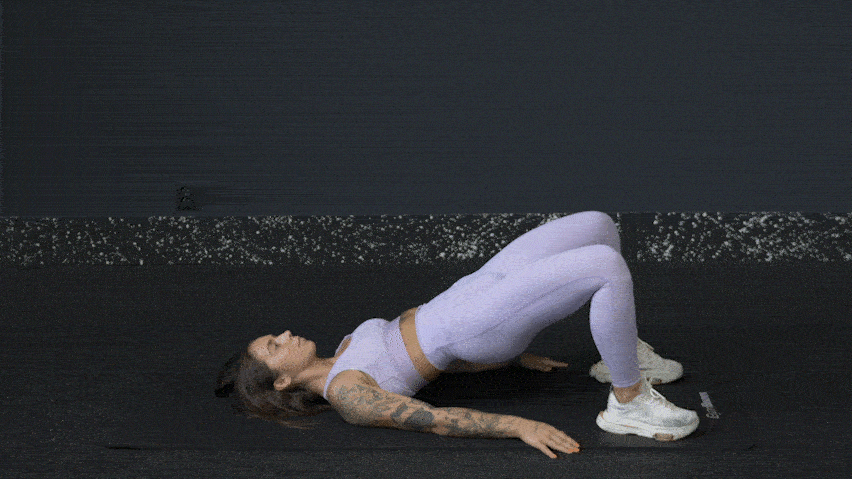
4. Side Lying Leg Lift
- Starting position: Lie on your side with your lower arm supporting your head and your upper arm bent, placing your palm on the ground. Bend the lower leg at the knee, and keep the upper leg extended.
- Execution: Upon exhaling, lift the upper extended leg upward (at least 30 cm off the ground), and then lower it down in a controlled manner. Immediately continue with the next repetition. Switch sides after completing the series.
- Common mistakes: Limited range of motion, uncontrolled movement.
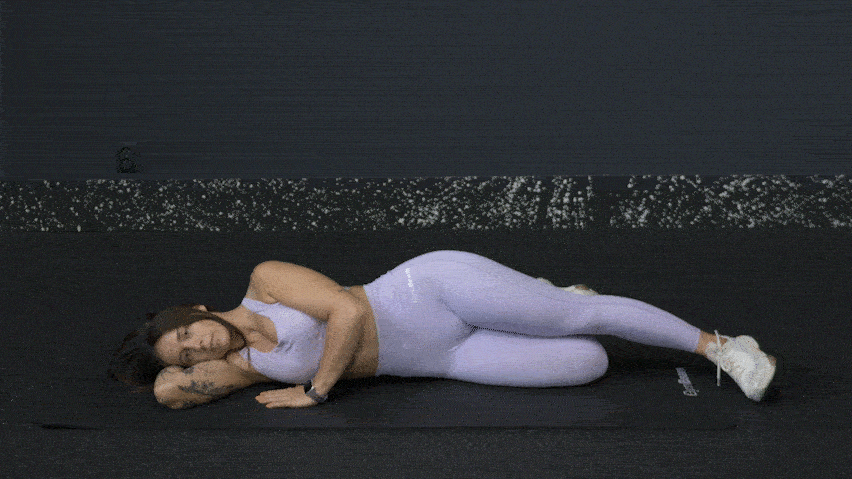
5. Resistance Band Leg Press
- Starting position: Lie with your back on a mat. Then bend one leg and bring the knee towards your chest. Take a long resistance band, hold it with your hands at opposite ends, and hook the middle part of it around the foot of the bent leg.
- Execution: Upon exhaling, push your foot against the resistance band and straighten your leg. Then return it to the starting position and continue with the next repetition. Switch legs after completing the entire series.
- Common mistakes: Limited range of motion, uncontrolled movement.
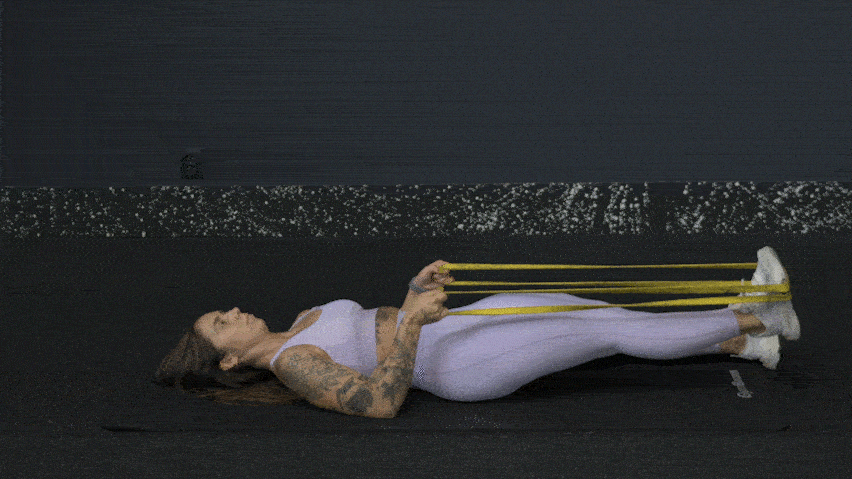
6. Calf Raise
- Starting position: Stand up straight with your hands placed on your hips.
- Execution: Exhale as you lift your heels off the ground and shift your body’s weight onto your toes. Then return to the starting position and continue with the next repetition.
- Common mistakes: Limited range of motion, uncontrolled movement.

Inappropriate sports activities
Some sports activities are inappropriate when dealing with knee issues. They could lead to the worsening of pain and other symptoms. Just like with suitable exercises, it’s always based on individual considerations and recommendations from a doctor. That said, for some people with knee problems, even these types of sports may be suitable. [7]
- This means exercises with a high impact on the joints (high-impact activities).
- These include activities like jumping exercises, squats, jump lunges, skiing, snowboarding, running, CrossFit, skipping, soccer, basketball, tennis, and other team sports.
- However, if you have no acute knee problems, it may be sufficient to support your knees with a knee support or have them taped (preferably by a professional) during these activities.
- On the other hand, people with healthy knees will find these activities really beneficial. When done in moderation, they serve as excellent prevention for joint-related issues. They help strengthen muscles, ligaments, and other supportive structures of the joints. Additionally, they support bone density, joint lubrication, and cartilage function. [8]
If you want to learn more about the impact of running on joint health, you can read the article: Does Running Damage Your Knees and Other Joints?
We have addressed issues related to the musculoskeletal system in other articles as well:
- Are you suffering from back pain? You can find the answer to what causes it most frequently and how to deal with it in the article: Back Pain: 10 Most Common Causes and Solutions to Get Rid of It
- You can learn about what can cause elbow pain in the article: Tennis Elbow and Golfer’s Elbow: What Causes Them and How to Get Rid of Them?
- If you also want to learn how to proceed with muscle injuries, read the article: What to Do With a Muscle Strain or Muscle Tear and How to Tell Them Apart?
What are the main takeaways?
You definitely shouldn’t leave sporting activities out of your life, even when you start experiencing knee problems. Instead, it’s better to focus on suitable types of exercises that benefit not only your fitness, but also support the mobility and overall function of your knee joints. For cardio, you can try activities like walking, swimming, or cycling. Yoga or specific stretching and rehabilitation exercises can then help with strengthening and improving the range of motion in your knees.
If you liked the article and know of someone who experiences knee pain, share it with them. Perhaps you can help them find suitable sports activities.
[1] Hospital for Special Surgery. The Best Types of Exercise for Sore Knees. – https://www.hss.edu/article_exercise-for-sore-knees.asp
[2] Orthopaedic, R.Can Swimming Help My Knee Pain? – https://www.raleighortho.com/blog/knee/can-swimming-help-my-knee-pain/
[3] Nordic walking for beginners: Exercising without having to worry. – https://www.bauerfeind-group.com/en/health/joint-pain/nordic-walking-for-beginners
[4] World Medical Hospital. Is cycling the best answer for knee osteoarthritis? – https://www.theworldmedicalcenter.com/en/new_site/health_article/detail/?page=262
[5] WHO: Physical activity. – https://www.who.int/news-room/fact-sheets/detail/physical-activity
[6] Verywell Health. The Benefits of Yoga for Bad Knees. – https://www.verywellhealth.com/yoga-for-bad-knees-5090430
[7] Physio. High-impact vs Low-impact Exercise: Which is Suitable for You? – https://dynamicphysio.co.nz/high-impact-vs-low-impact-exercise-which-is-right-for-you/
[8] Haden, R. High-Impact and Low-Impact Exercise. – https://www.mana.md/high-impact-and-low-impact-exercise/
[9] Exercises for knee muscle and joint problems. – https://www.nhsinform.scot/illnesses-and-conditions/muscle-bone-and-joints/exercises/exercises-for-knee-problems


Add a comment